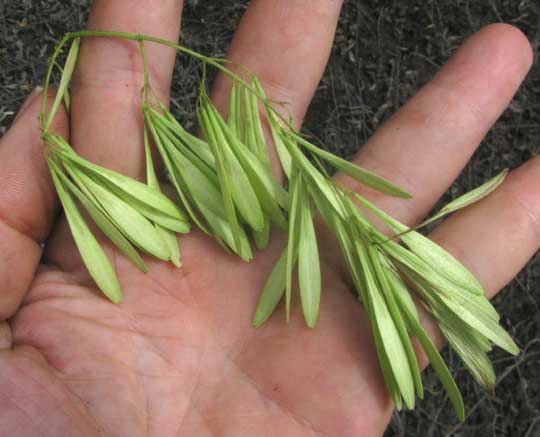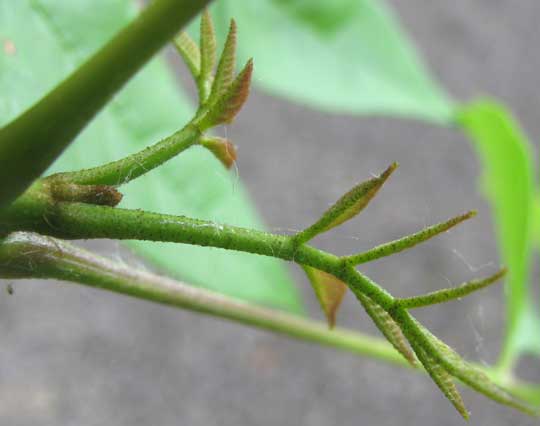Excerpts from Jim Conrad's
Naturalist Newsletter
from the April 22, 2012 Newsletter, issued from near Natchez, Mississippi
GREEN ASH FRUITING
In an often-flooded bottomland woods in St. Catherine Creek National Wildlife Refuge where about the only trees to be seen were Black Willows and Baldcypresses, something different appeared along the road. These trees' summery-looking green boughs were heavily laden with basketball-sized clusters of very pale, shining, samara-type fruits.
With such fruits it had to be an ash tree, but which species? In this part of the world three swamp-loving ash species are possible, the Pumpkin, Carolina and Green Ashes, plus there's an upland one, the White Ash. Also, these trees all were in a straight row at the swamp's edge, so clearly they'd been planted and therefore could have been just about anything. Therefore I had to wade through knee-deep water in which we'd just spotted a big Cottonmouth snake a few feet away to take a closer look -- to "do the botany." You can see a tree's opposite, pinnately compound leaf below:

The leaflets had very short stems, or petiolules, so right there was a vote for it not being White Ash, whose leaflets normally have longer petiolules. Also, White Ash leaflets usually are conspicuously pale below, and these were greenish, so I eliminated White Ash from my list of possible species.
The most important way to distinguish ashes usually is to look at the samara-type fruits. A samara is a winged fruit that does not split open at maturity -- it's indehiscent. The best known plants producing them are maples and ashes. You can see a fallen panicle our trees' pale, rather slender samaras below:

The wings on Carolina Ash samaras are very wide so ours wasn't that one. Pumpkin Ashes are usually distinguished by their very hairy leaves and twigs. Our trees' leaves and twigs were essentially hairless, so it wasn't that.
That left the Green Ash, FRAXINUS PENNSYLVANICA, which I'd figured it was all along, since Green Ashes are the most widely distributed of all American ashes, and are know to be a vigorous species liking swampy places.
Green Ashes are often planted in towns because they produce such pretty shapes and grow under many conditions. However, the species is now threatened in some parts of the country, particularly Michigan, by the Emerald Ash Borer, a beetle introduced accidentally from Asia.
A nice picture showing two leaves expanding from a growing twig tip, with the brownish terminal bud between their petiole bases, is shown below:
